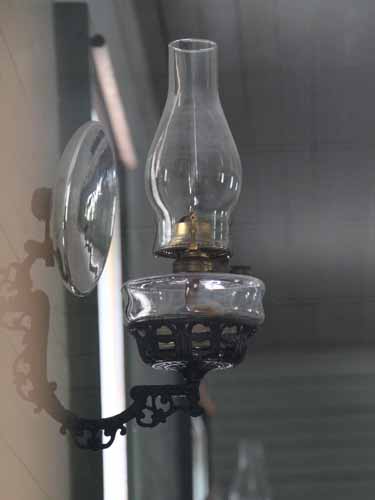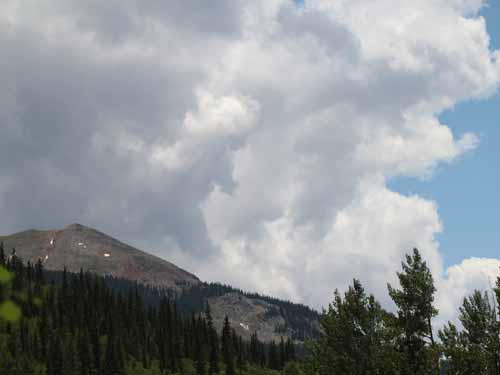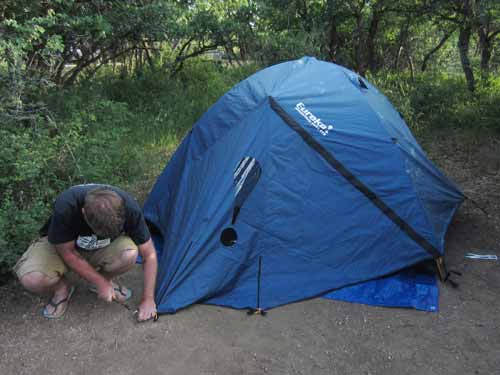We visited the Town Hall and jail, then crossed over the river to see the old school house. Both of these buildings had been restored and were in the process of becoming museums (of a sort).

St. Elmo town hall & jail

Inside

The jail

The town was in the process of gathering more items and photos for the exhibit.

Chalk Creek

The old school house

Can't you just imagine the sound as it rocks back and forth!?

Some of the old items on display (it was all behind glass, so please forgive the reflections)



Note the mirror behind the lamp, which helped scatter the light further.
We began heading back to the car. Originally we had thought about continuing on to the tiny town of Tincup... but it was a 4-wheel drive road only.

Behind one of the sheds was a bright pink buggy. But even cuter than it was who was behind the wheel!!...


The clouds began to roll in.

Wow! I wonder if they found anything.

Passing by a hummingbird feeder back near the gift shop

The vibrant marking of the male Broad-tailed Hummingbird.
We got back to the car and retraced our steps back to the highway. From there we made our way over to the Black Canyon of the Gunnison.

Leaving the mountains

A quick lunch stop. Blue Mesa Lake is the largest lake in Colorado, created in 1965 by the Blue Mesa Dam. It is part of the extensive Colorado River Storage Project, which serves the local communities as a means of water for irrigation, flood control, hydro-electric power and recreation.

We pulled into the South Rim Campground (located within the national park) and got our tent set up by 7 pm. It was lovely weather. There were chipmunks and ground squirrels everywhere. The grass and trees rustled and crackled with their movements. One curious chipmunk came all the way up to the tent to have a look in at us, sitting briefly on Regan's shoes which were just outside the door. A deer wandered through the campground with her young fawn.



Our incredibly healthy meal. Oh, and we also had some leftover onion buns and watermellon.

Bear warning signs were posted everywhere, even on our picnic table. Black Bears (although many of them are only 'black' in name for they can be any shade of brown, cinnamon or beige) can smell food up to 5 miles away. This, combined with their innate curiosity, can make for problems at campsites. Therefore, all food (and scented items) should be stored in the car of a special bear-proof storage box.

The light begins to recede on the mountains.


A chipmunk (they have the stripes on their eyes; ground squirrels don't) finds a meal in a tree.

The deer seemed fearless in the campground, even with all the dogs about.

Mule deer fawns have built-in protection from predators. First, since many predators have a good sense of smell, the fawns are born with no odor. Second, most predators only see in black and white. The fawn's pattern and creamy coat make it near to invisible in the grass and leaves.

Following mom away. A female mule deer usually gives birth to two fawns, although if it is her first time having a fawn, she often only has one.

Bird song was also plentiful.
Just down the road, an ranger program was being held. The subject of this evening's presentation: the park's predators. We were a bit late but still learned a lot.

According the the ranger, a mountain lion could easily jump over this back board.

Pelts, skulls, photos, models of footprints, and (fake) scat from (top to bottom): mule deer, elk, black bear, coyote and bobcat

A mule deer

An elk.... surprisingly quite different from the deer!

A bighorn sheep. Note that they have permanent horns, while the deer and elk have antlers that they shed every year.

A black bear

A mountain lion
We walked back to the tent as the final rays of the day disappeared and went to sleep early. Unfortunately in the middle of the night, I had to make a run to the facilities (aka the pit toilets). So I grabbed the small lantern and made the long walk through the dark. With all the recent images of bears and mountain lions, my imagination was wild with every small noise. With each stride, the swinging lantern cast long, dark, moving shadows at every turn. At one point, something did leap from the bushes and dart past! My heart jumped... but it was only a bunny.
I was a bit more accustomed to the night, its sounds and shapes, by the time I started to head back. I was calm enough to even notice the sky. It was stunning! There were zillions of stars. The Milky Way was draped across the heavens like a warm blanket. Visibility was so good that I could even see the large 'rip' in it. In astronomy, this dark line is known as the Great Rift and is basically a series of overlapping, non-luminous dust clouds blocking out the stars behind them. But I preferred to think back to a story I had heard in New Zealand while visiting a working 'Stonehenge' site. The story is this:
Orion was a great hunter, but very boastful. One day he was sitting with the male gods and, in a drunken stupor, claimed he was capale of killing every animal. Artemis (also known as Diana, goddess of the hunt) overheard him and didn't want him killing all HER animals. So she sent a giant scorpion to kill him. It tore its way through the Milky Way, leaving a large black rift. It was a tremendous fight but the scorpion finally prevailed and killed Orion. This upset the male gods immensely, so they brought him up from the underworld to the sky and made him immortal. In her continued rage, Artemis then gave the scorpion immortality too and made it chase Orion across the heavens for all eternity. This is the story of the seasons in the Southern hemisphere. When Orion peeks over the horizon and doesn't see the scorpion, he feels free to come out and wander about the sky and it starts to become summer. When he sees the scorpion coming up behind him, he disappears again and the scorpion searches the sky for him and it starts to become winter. When they can both be seen, it is the equinoxes.


